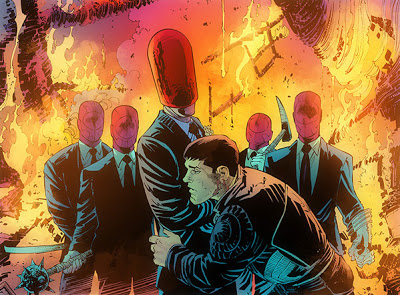Writer: Scott Snyder, James Tynion IV (backup)
Penciller: Greg Capullo
Inker: Danny Miki
Colorist: FCO Plascencia
Publisher: DC Comics
The non-linear narrative device is one of the trickiest to use in fiction. At its best, it’s Pulp Fiction or Ulysses. At its worst, it’s The Grudge or the wacky anime Axis Powers Hetalia. However, Batman #23 uses the non-linear narrative to show Bruce Wayne at different stages of his crime fighting career and thus to reveals the struggle and events that transformed into Batman. The non-linear narrative works because it is tied together by the framing device Thomas Wayne talking to Bruce when he falls into a hole on the grounds as a child. FCO Plascencia also uses a different color scheme to distinguish between the various narrative threads. In addition to its engaging narrative structure, Batman #23 does an excellent job exploring the psyches of the villains Red Hood and Riddler as well as their relationship with Bruce Wayne. There is also another fun backup story looking at Bruce’s training and brutal art from Greg Capullo.
From the first page, Scott Snyder and Greg Capullo show the reader the three narrative threads in Batman #23 which are Thomas Wayne talking to young 
The legacy of Thomas and Martha Wayne pervades Batman #23 and could possibly be the motivation of the Red Hood, who has his lengthiest appearance in this issue. The Red Hood claims that he was motivated to commit random crimes because of the emptiness he felt after Thomas and Martha Wayne were murdered. He says that he is a madman, and that “All you can do is fear and survive”, but Red Hood is surprisingly well-organized and has made common Gothamites into sleeper agents for him. Even though he doesn’t reveal Red Hood’s identity yet, Snyder crafts an interesting, nihilist villain who has personal connection to Bruce Wayne and the vigilante that will become Batman. The Riddler also has an extended scene in this issue, and his talk of games and moves makes him a perfect foil for the more violent and chaotic Red Hood. Snyder strips the campiness and bad jokes from Riddler and turns him into a intelligent, pragmatic strategist that will continue be a formidable mental threat to the young Batman. “Zero Year” also acts an origin story for him showing how the eccentric consultant Edward Nygma became the legendary supervillain Riddler.
Greg Capullo and inker Danny Miki turn in some more excellent art in Batman #23. Bruce takes a beating in this issue, and Capullo doesn’t shy away from showing the blood dripping from his wounds and his battered body struggling to find help. He also uses black silhouettes of characters like Bruce and Alfred to highlight important scenes. It seems that in the majority of Batman issues that Capullo does something completely mindblowing with his art. In Batman #23, Capullo uses a classic nine panel grid to illustrate the different narrative threads of this issue. He intersperses Bruce getting beat to a pulp and breaking into Wayne Manor with him getting medical attention from his father after falling into a hole. In nine visceral panels, he summarizes the basic story of this issue and foreshadows Bruce Wayne’s eventual transformation into Batman. FCO Plascencia uses different color backgrounds to show the different stories. Wayne Manor is black and grey, like Batman’s costume. The fight with the Red Hood Gang is obviously red, and the scenes with Thomas Wayne are pitch black representing young Bruce’s fear. The art and colors of Batman #23 add depth to its engaging narrative while also making the story easy to follow. Rafael Albuquerque uses a similar nine panel grid in the backup story to highlight a scene where a 24 year old Bruce Wayne begins to realize the power of fear against criminals. This is the most action packed backup story yet and adds an extremely important element to the Batman mythos.
Even though there is already Batman: Year One and Batman Begins, “Zero Year” is a story that needs to be told. It delves into why Bruce Wayne became Batman and also explores his relationship with his family, enemies, and Gotham itself. Snyder, Capullo, Miki, and Plascencia bring Bruce Wayne to his breaking point with their writing and art and then build him back up. Batman #23 continues to build the legend of the Batman and explore him as a man too.

